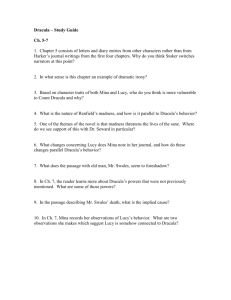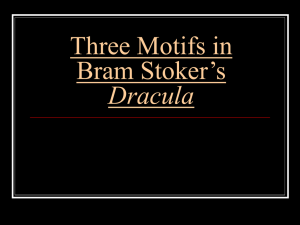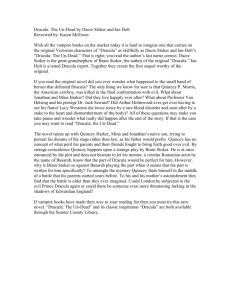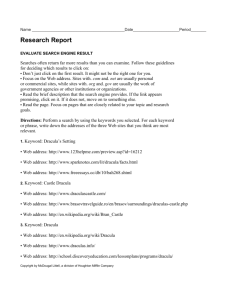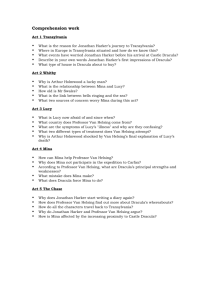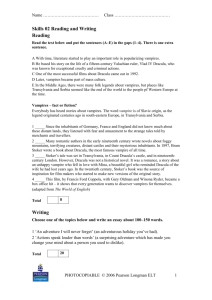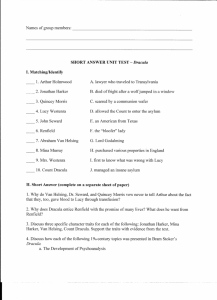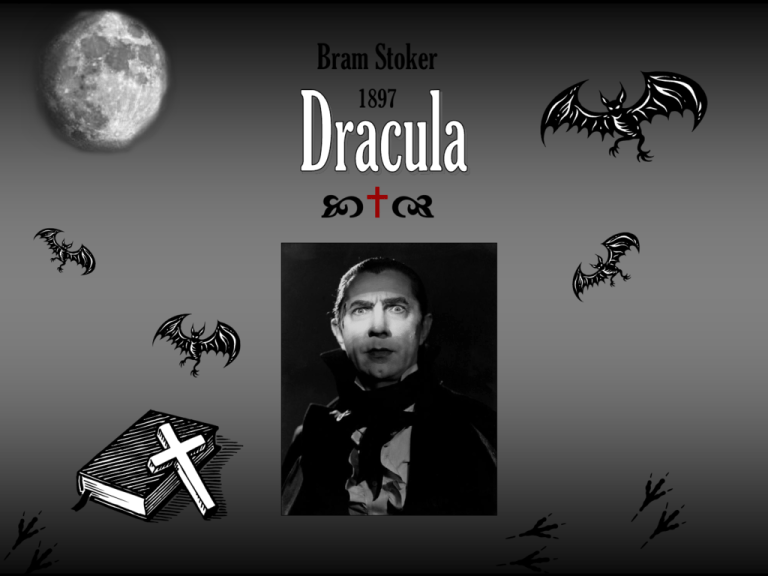
Bram Stoker
1897
Author Mini Biography
Settings
Characters
Plot Summary
Literary Elements
Quotes From Text
Critical Analysis
Work Division
References
Abraham (Bram) Stoker was born in Dublin, Ireland in 1847. Until the age
of seven, he was bedridden, always on the verge of death. Nonetheless,
after recovering fully from his illness, he became a star athlete at Trinity
College, in Dublin.
Although Stoker managed to write a number of novels, he was not primarily an
author by profession. In 1878 he began to work with his friend, the famous actor
Henry Irving, as a manager at London's Lyceum Theatre. His first novel, The
Snake's Pass, was published in 1890. That same year he began work on Dracula,
which was first published in 1897. In 1900, a paperback version was released.
Few people still read The Mystery of the Sea (1902), The Jewel of the Stars
(1903) or The Lair of the White Worm (1911); Dracula is generally considered
Stoker's only great novel.
Dracula is an example of Gothic literature, a genre that began over a century
earlier with Henry Walpole's The Castle of Otranto (1764). Few Gothic novels,
though, have enjoyed the long-lasting popularity of Dracula. While some doubt its
value as literature, there can be little doubt of its longevity and allure. However,
Dracula was one of the last books of the genre. Nonetheless, its effect can be
seen in modern-day writers such as Joyce Carol Oates and Anne Rice.
Part of that allure comes from the dark sexual implications of the novel. The irony
is that Stoker himself believed immoral sexual content should be censored, a
view he out forth in an article called "The Censorship of Fiction" published in
Nineteenth Century and After in 1908.
Bram Stoker died in 1912
The setting of Dracula is medieval Europe at the end of the ninteenth century.
Stoker relies heavily on the conventions of Gothic fiction, a genre that was
extremely popular in the early nineteenth century. Gothic fiction traditionally
includes elements such as gloomy castles, sublime landscapes, and innocent
maidens threatened by ineffable evil. Stoker modernizes this tradition in his
novel, however, moving from the conventional setting of Dracula’s ruined
castle into the bustle of modern England. Stoker portrays the collision of two
disparate worlds—the count’s ancient Transylvania and the protagonist’s
modern London.
Dracula is a Transylvanian count who has been "Un-Dead" for several hundred years. He keeps his vitality
by sucking blood from live victims which motivates his desire to move from the barren and desolate
Transylvania, which is sparsely populated, to the more populous England.
Jonathan Harker is the London solicitor who is sent to Transylvania to finalize the transfer of real estate in
England to Count Dracula. He keeps account of his stay at the Castle Dracula by journal. Harker is engaged to
Mina Murray.
Miss Mina (Wilhelmina) Murray is the fiancée of Jonathan Harker; is an assistant schoolmistress. She will
later become Mina Harker and will assist in tracking down Count Dracula.
Miss Lucy Westenra is Mina Murray's closest friend. Draculas first victim. After her "death," she becomes
one of the "Un-Dead."
Arthur Holmwood is A vigorous man, twenty-nine years old, the only son of Lord Godalming; Holmwood will
later inherit this title after the death of his father. His affection for Lucy convinces him join in hunting Dracula.
Dr. John Seward is the head of a lunatic asylum, Seward is roughly the same age as
Holmwood and is one of Lucy Westenra's suitors. He is an intelligent and determined man.
Quincey P. Morris is another of Lucy's suitors. Morris is an American from Texas. His
great wealth allows him to pay many of the expenses incurred in tracking down Dracula.
Dr. Abraham Van Helsing is an M.D., a Ph.D., and a D.Litt., as well as an attorney. He is
a lonely, unmarried old bachelor who is both kindly and fatherly. He is from Amsterdam, and
his profound knowledge of medicine, folklore, and the occult allows him to take complete
charge of Lucy's illness, which he identifies immediately as vampirism. He is also chiefly in
charge of the strategy of tracking down Count Dracula.
R. M. Renfield is fifty-nine-year-old mad patient of Dr. Seward; he also comes under the
influence of Dracula.
Dracula begins with the journal of Johnathan Harker, a young solicitor on the way to Transylvania to give
information to Count Dracula about his new estate in London. Dracula takes the Harker prisoner, he
witnesses many strange and evil things before escaping into the night. He later decides he must have
been mad.
Meanwhile, back in England, Johnathan’s fiancée, Mina, visits her friend Lucy. Lucy just decided to marry
Arthur Holmwood after refusing other suitors. Dracula, who is moving to London to feast on more
humans, happens to land in the area Mina and Lucy are staying. His first victim is Lucy.
Dr. Seward, who, by coincidence, runs the insane asylum next door to Dracula's primary London home,
tries to treat Lucy's 'illness.' He calls in from Amsterdam his friend and mentor Professor Abraham Van
Helsing. Van Helsing figures out what is wrong with Lucy, but cannot save her. By this time, Jonathan
has made it home to England and is happily married to Mina.
Van Helsing brings together Mina, Jonathan, Arthur, Quincey, Seward and himself and convinces
everyone of the reality of vampires and the danger of this particular one, who was in his human life a
great warrior and thinker. They have already The men find out about Dracula's activities and step up their
efforts. They manage to drive him out of England, but realize that if they fail to finish the job then Mina will
become a vampire anyway.
They follow his trail to Transylvania, where he and his faithful gypsies manage to keep outwitting them.
Finally, minutes before he reaches his castle, the entire team descends upon him while he is being
transported in his box of Transylvanian earth. Jonathan and Quincey kill him, though not before Quincey
himself is mortally wounded. With Mina free from her fate, the rest return to England and remain lifelong
friends.
Tone - Gothic, dark, melodramatic, righteous
Point of view - Shifts among the first-person perspectives of several characters
Themes -The promise of Christian salvation; the consequences of modernity; the
dangers of female sexual expression
Conflict - Stoker's novel deals in general with the conflict between the world of the
past — full of folklore, legend, and religious piety — and the emerging modern world
of technology, positivism, and secularism.
rational/superstitious conflict
"When the Count saw my face, his eyes blazed with a sort of demonaic fury, and he
suddenly made a grab at my throat. I drew away, and his hand touched the string of beads
which held the crucifix. It made an instant change in him, for the fury passed so quickly that
I could hardly believe that it was ever there." Chapter 2, pg. 28
...[A] man, tall and thin, and ghastly pale... I crept behind It, and gave It my knife; but the
knife went through It, empty as the air." Chapter 7, pg. 93
"I don't want to talk to you: you don't count now; the Master is at hand." Chapter 8, pg. 111
"I am here to do Your bidding, Master. I am Your slave..." Chapter 8, pg. 113
"It will be a painful task for you, I know, old friend, but it will be for her sake, and I must not
hesitate to ask, or you to act." Chapter 9, pg. 121
"I shall cut off her head and fill her mouth with garlic, and I shall drive a stake through her
body." Chapter 15, pg. 221
"As he [Van Helsing] placed the Wafer on Mina's forehead, it had seared it - had burned
into the flesh as though it had been a piece of white hot metal." Chapter 22, pg. 327
Religious
The folk legends and traditions Van Helsing draws upon suggest that the most effective weapons in combating
supernatural evil are symbols of unearthly good. Indeed, in the fight against Dracula, these symbols of good take the form
of the icons of Christian faith, such as the crucifix. The novel is so invested in the strength and power of these Christian
symbols that it reads, at times, like a propagandistic Christian promise of salvation.
The vampires’ drinking of blood echoes the Christian rite of Communion, but in a perverted sense. Rather than gain eternal
spiritual life by consuming wine that has been blessed to symbolize Christ’s blood, Dracula drinks actual human blood in
order to extend his physical life. The importance of blood in Christian mythology elevates the battle between Van Helsing’s
warriors and the count to the significance of a holy war or crusade.
The Weird Sisters
The three beautiful vampires Harker encounters in Dracula’s castle are both his dream and his nightmare—indeed, they
embody both the dream and the nightmare of the Victorian male imagination in general. The sisters represent what the
Victorian ideal stipulates women should not be—voluptuous and sexually aggressive—thus making their beauty both a
promise of sexual fulfillment and a curse. These women offer Harker more sexual gratification in two paragraphs than his
fiancée Mina does during the course of the entire novel. However, this sexual proficiency threatens to undermine the
foundations of a male-dominated society by compromising men’s ability to reason and maintain control. For this reason,
the sexually aggressive women in the novel must be destroyed.
The Czarina Catherine
The Czarina Catherine is the name of the ship in which Dracula flees England and journeys back to his homeland. The
name of ship is taken from the Russian empress who was notorious for her -promiscuity. This reference is particularly
suggestive of the threat that hangs over Mina Harker’s head: should Van Helsing and his men fail, she will be transformed
into the same creature of appetites as Lucy.
Title, Author, Publishing Date- Dustin
Author Mini Biography- Bree
Settings- Dustin
Character Discriptions- Rianna
Plot Summary- Amy
Literary Elements- Rianna
Quotes- Amy
Critical Analysis- All
Work Division- Bree
References- Bree
The story of Dracula was
very interesting, and at
some times exciting. But
in my opinion it was slow
paced and was packed
with a lot of distracting
dialogue. I think Dracula
had a lot of thought
provoking subject material
and good historical
references making the
story more believable.
What I took away from the
story is a newly acquired
understanding of the tale.
Though the idea of Dracula
is introduced to everyone
sometime early on, you
cannot fully understand
Bram Stokers meaning of
the story until you read the
book.
http://media-imdb.com/media/rm347707648tt0021814
Http://www.bookrags.com/notes/fra/SUM.html
www.cliffsnotes.com
www.wikipedia.com
www.sparknotes.com
Stoker, Bram. Dracula. Unabridged. Mineola: Dover Publications, 1897.

